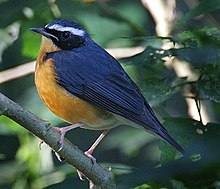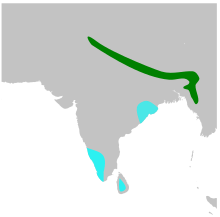Indian blue robin
| Indian blue robin | |
|---|---|

| |
| Male in winter | |
| Scientific classification | |
| Kingdom: | |
| Phylum: | |
| Class: | |
| Order: | |
| Family: | |
| Genus: | |
| Species: | L. brunnea
|
| Binomial name | |
| Larvivora brunnea | |

| |
| Breeding area in green and wintering areas in blue | |
| Synonyms | |
|
Erithacus brunneus | |
The Indian blue robin (Larvivora brunnea) is a small bird found in South Asia. Formerly considered a thrush, it is now considered one of the Old World flycatchers in the family Muscicapidae. It was earlier also called the Indian blue chat. It is migratory, breeding in the forests along the Himalayas of Nepal, India and Myanmar. They winter in the hill forests of the Western Ghats of India and in Sri Lanka.
Taxonomy
The Indian blue robin was previously placed in the genus Luscinia. A large molecular phylogenetic study published in 2010 found that Luscinia was not monophyletic. The genus was therefore split and several species including Indian blue robin were moved to the reinstated genus Larvivora.[3][4]
Description

The Indian blue robin is similar in size to the related bluethroat at 15 cm long. The adult male has blue upperparts and rufous underparts. A bright white supercilium contrasts with a black mask that continues down the neck. The lower belly and undertail are also whitish. The female is olive brown above and buff below with a light eye-ring and rufescent rump. The breast and flanks are buffy.[5][6]
Young birds are dark brown with buff spots.[7][8]
Distribution
The nominate race breeds from Eastern Afghanistan to the eastern Himalayas. Race wickhami (Stuart Baker, 1916) breeds in the Chin Hills of western Myanmar and is said to be non-migratory.[9]
Behaviour and ecology
The Indian blue robin is insectivorous and feeds mainly on the ground. It skulks in undergrowth and hops on the ground, frequently flicking and fanning its tail.[5] The breeding season is May to July and the nest is a large cup of vegetation placed on the ground between the roots of large fir tree or in depression. The nest is lined with roots, hair and down. The usual clutch is 4 light blue eggs.[9][10] Only the female is believed to incubate but both sexes take part feeding the young.[7] The cuckoo Cuculus canorus has been recorded in old literature as a brood parasite of the species.[9]
These birds arrive in the Himalayan breeding grounds in May and leave in September. Southward migration begins in August. During the migratory season they may be found as passage migrants all over peninsular India.[9][11][12] In winter they are found mainly in the hill forests of southern India,[13] the Western Ghats and in Sri Lanka. They arrive in mid-September and leave the winter quarters in mid April. Males appeared to be commoner than females in a survey conducted in the Nilgiris suggesting either differences in the timing of migration of males and females or variation in wintering areas.[14][15] At Point Calimere they have been regularly trapped during October November on their return migration from Sri Lanka but rarely on the southward migration with suggestions that they may follow different routes.[16]
The habitat in which they are found is usually dense and dark forest with undergrowth and leaf litter. They sing and call in their winter grounds. The song consists of sudden and sharp series of whistles ending in a rapid series of notes. They also utter a sharp and low clicking alarm note.[5]
References
- ^ Template:IUCN
- ^ Hodgson, Brian Houghton (1837). "On three new genera or sub-genera of long-legged thrushes, with descriptions of their species". The Journal of the Asiatic Society of Bengal. 6: 102.
- ^ Sangster, G.; Alström, P.; Forsmark, E.; Olsson, U. (2010). "Multi-locus phylogenetic analysis of Old World chats and flycatchers reveals extensive paraphyly at family, subfamily and genus level (Aves: Muscicapidae)". Molecular Phylogenetics and Evolution. 57 (1): 380–392. doi:10.1016/j.ympev.2010.07.008.
- ^ Gill, Frank; Donsker, David, eds. (2016). "Chats, Old World flycatchers". World Bird List Version 6.2. International Ornithologists' Union. Retrieved 20 May 2016.
- ^ a b c Rasmussen, PC; JC Anderton (2005). Birds of South Asia: The Ripley Guide. Volume 2. Smithsonian Institution and Lynx Edicions. p. 393.
- ^ Baker, ECS (1924). Fauna of British India. Birds. Vol. 2 (2 ed.). Taylor and Francis, London. pp. 14–15.
- ^ a b Ali, S; S D Ripley (1997). Handbook of the birds of India and Pakistan. Vol. 8 (2 ed.). Oxford University Press. pp. 229–231. ISBN 0-19-562063-1.
- ^ Ali,S; Whistler,H (1935). "The ornithology of Travancore and Cochin, part 3". J. Bombay Nat. Hist. Soc. 38 (2): 282–320.
- ^ a b c d Whistler, Hugh (1949). Popular Handbook of Indian Birds. Fourth edition. Gurney and Jackson. pp. 83–85.
- ^ Vietinghoff-Scheel, Erika V. (1989). "Luscinia brunnea". Atlas der Verbreitung palaearktischer Vögel, 16 (PDF) (in German). Akademie Verlag, Berlin.
- ^ Prasad,JN; Srinivasa,TS (1992). "Indian Blue Chat Erithacus brunneus (Hodgson) in Bangalore". J. Bombay Nat. Hist. Soc. 89 (2): 257.
- ^ Bharos, Ajit (1992). "Sighting of an Indian Blue Chat Erithacus brunneus (Hodgson) at Raipur, Madhya Pradesh". J. Bombay Nat. Hist. Soc. 89 (3): 377.
- ^ Shivanand, Thejaswi; A. Shivaprakash (2004). "Indian Blue Robin Luscinia brunnea winters at Chamundi Hill and Ranganathittu Bird Sanctuary, Mysore, South India" (PDF). Newsletter for Ornithologists. 1 (4): 54–56.
- ^ Khan, A. R. (1980). "Wintering habits of the Blue Chat (Erithacus brunneus) (Hodgson), in the Nilgiris, southern India". J. Bombay Nat. Hist. Soc. 75 (3): 1153–1156.
- ^ Prasad, J. N., S. Karthikeyan and S. Subramanya (1995). "Wintering of Indian Blue Chat, Erithacus brunneus (Hodgson) and Pied Ground Thrush Zoothera wardii Blyth at Nandi Hills, south India". J. Bombay Nat. Hist. Soc. 92 (1): 267–269.
{{cite journal}}: CS1 maint: multiple names: authors list (link) - ^ Sugathan,R (1982). "Some interesting aspects of the avifauna of the Point Calimere Sanctuary, Thanjavur District, Tamil Nadu". J. Bombay Nat. Hist. Soc. 79 (3:567–575).

